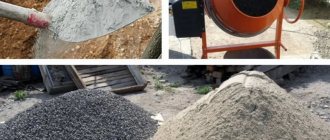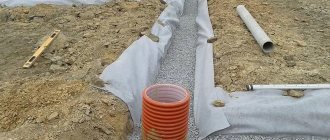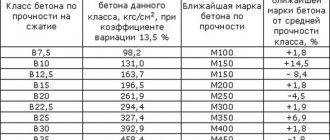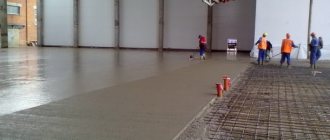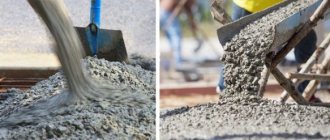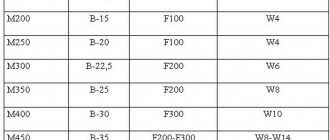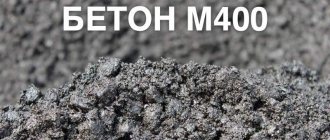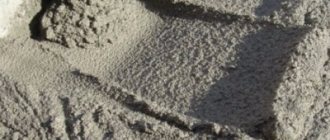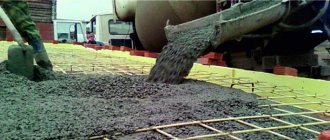A properly prepared concrete solution at home means precise adherence to the proportions of substances, proper preparation and adherence to mixing technology, and uniform distribution of components in the liquid mixture. Manual mixing of the solution will not give such homogeneity as preparing concrete in a concrete mixer. This method is used when preparing large volumes of mortar - for the construction of a foundation, when laying the walls of a house, for the manufacture of floor slabs.
How to mix concrete in a concrete mixer
Features of working with a concrete mixer
If you prepare the mixture in a concrete mixer, the concrete will be 40% stronger than when mixing the mixture with a shovel. In addition, a concrete mixer saves labor, time and financial costs, as well as a high speed of obtaining results.
Standard components of the prepared solution: Portland cement, purified quarry or river sand, medium and coarse crushed stone, clean water. For formulations with special requirements, modifiers and plasticizers are mixed into the composition. The quality of the components determines the properties of solid concrete such as strength, frost resistance, moisture resistance, ductility and other characteristics.
- Increased demands are placed on Portland cement - it must be a high-grade material containing ≥ 80% calcium silicate;
- The sand must be cleaned (washed), without any admixtures of greasy clay or debris. The grains should be 1.5-5 mm in size;
- Coarse aggregate crushed stone or gravel - should be of large and medium fractions - from 20 to 70 mm.
Crushed stone fractions
Component ratio for M 400:
| Branded concrete | Ratio by weight (Portland cement, sand, crushed stone or gravel), kg | Volume ratio per 10 liters of Portland cement, (Portland cement, sand, crushed stone or gravel), liters | Volume of concrete solution obtained from 10 liters of Portland cement, liters |
| M 100 | 1,0 : 4,6 : 7,0 | 41,0 : 61,0 | 78,0 |
| M 150 | 1,0 : 3,5 : 5,7 | 32,0 : 50,0 | 64,0 |
| M 200 | 1,0 : 2,8 : 4,8 | 25,0 : 42,0 | 54,0 |
| M 250 | 1,0 : 2,1 : 3,9 | 19,0 : 34,0 | 43,0 |
| M 300 | 1,0 : 1,9 : 3,7 | 17,0 : 32,0 | 41,0 |
| M 400 | 1,0 : 1,2 : 2,7 | 11,0 : 24,0 | 31,1 |
| M 450 | 1,0 : 1,1 : 2,5 | 10,0 : 22,0 | 29,0 |
Component ratio for M 500:
| Branded concrete | Ratio by weight (Portland cement, sand, crushed stone or gravel), kg | Volume ratio per 10 liters of Portland cement, (Portland cement, sand, crushed stone or gravel), liters | Volume of concrete solution obtained from 10 liters of Portland cement, liters |
| M 100 | 1,0 : 5,8 : 8,1 | 53,0 : 71,0 | 90,0 |
| M 150 | 1,0 : 4,5 : 6,6 | 40,0 : 58,0 | 73,0 |
| M 200 | 1,0 : 3,5 : 5,6 | 32,0 : 49,0 | 62,0 |
| M 250 | 1,0 : 2,6 : 4,5 | 24,0 : 39,0 | 50,1 |
| M 300 | 1,0 : 2,4 : 4,3 | 22,0 : 37,0 | 47,0 |
| M 400 | 1,0 : 1,6 : 3,2 | 14,0 : 28,0 | 36,1 |
| M 450 | 1,0 : 1,4 : 2,9 | 12,0 : 25,0 | 32,0 |
Sand fractions
Modifying additives in concrete:
- Fluff lime (slaked lime) – increases the ease of working with the mixture (workability);
- Plasticizers that increase the fluidity of the solution;
- Modifiers for accelerated setting of the mixture at high air humidity, low temperatures or waterlogging of the solution;
- Reinforcing stabilizers.
How to calculate proportions?
When making a solution in small quantities, you can use a bucket as a measuring container.
The main components of structural concrete are cement, water, sand and additional additives. If it is necessary to obtain a solution with increased strength and reliability, use concrete made from ASG - a sand-gravel mixture. If you need to produce a relatively small volume of concrete, it is recommended to use a bucket as a measuring container. It is important to take into account here that all components of the solution with the same volume have different masses. The proportions of concrete in buckets are calculated in kilograms. The weight of cement, sand and crushed stone in one 10-liter bucket will be 15, 19 and 17.5 kg, respectively. The number of components is mixed depending on the required cubes. The optimal proportions C: P: SCH in 1 m³ of concrete dough are 2: 5: 9.
Component proportions
Before mixing the concrete solution, the optimal ratio of components is selected, taking into account the area of use of concrete:
- Mixtures with minimal ultimate strength are poured into the foundation pad or formwork;
- For structures with maximum permissible loads, we prepare a mixture using a grade of Portland cement ≥ M 400;
- Water is added in a volume of ≤ 50% of the volume of binders. A standard batch of concrete in a concrete mixer should maintain the following proportions: 1.0 : 3.0 : 6.0 : 0.5 (Portland cement – sand – aggregate – water).
For any volume of the concrete mixer, taking into account the inclined position of the device’s tank, the loading of the dry mixture should not exceed 1/3 of the total volume of the tank. Standard volume – 180 liters. To mix concrete grade M 400, you will need 14 kg of fresh Portland cement, 42 kg of clean sand, 84 coarse crushed stone, 7 liters of clean water. As a result, you will get 60 liters (147 kg) of liquid concrete solution.
Preparing the mixture
Preparation and procedure:
- Preparation of fillers, binders, mixing fluid;
- Preparing a concrete mixer;
- Loading all components into the tank;
- Mixing, adding plasticizers and modifiers;
- Unloading the finished mixture;
- Putting the concrete mixer and tools in order.
Important: the sequence of adding substances to the concrete mixer must be strictly and strictly observed - first load water, then dry aggregates, and mix them. If you change the order and loading order of the components, the consistency of the mixture will be disrupted. Allow 1-2 minutes between adding fillers.
The solution should not remain in the concrete mixer for a long time, and the standards limiting the time of its use are specified in GOST 7473-94. The mixing time depends on the water-cement ratio, and for forced mixing concrete mixers - 50-120 seconds, and if you mix concrete in a gravity-type concrete mixer - 60-150 seconds.
Component ratio
The main thing that novice builders who are thinking about how to prepare concrete in a concrete mixer needs to know is to maintain proportions.
The strength and mobility of the future structure depends on the ratio of cement, sand, gravel and water. When preparing the concrete mixture yourself, it is enough to adhere to the proportion 2 * 4 * 8 * 1.
The specified ratio makes it possible to obtain concrete of medium strength, while its quality depends on the brand of cement. So, if you use M 350 cement in the above ratio, then the grade of the finished mixture will be M200.
To obtain 60 liters of ready-made concrete solution (approximately 145-150 kg), you will need:
- cement – 21 kg;
- sand – 42 kg;
- coarse gravel - 84 kg;
- water – 10-11 l.
Types of concrete mixers and operating principle
The standard technology for preparing concrete in a concrete mixer involves the use of two types of units:
In a direct mixer, dry substances are mixed in a stationary tank, inside of which rotating blades are installed;
Gravity concrete mixers are a rotating pear-shaped or cylindrical tank with a hatch for loading aggregates and unloading liquid concrete solution. The tank is mounted on a metal frame, has its own drive and internal blades. The axis of the tank can change its position to use gravitational forces for mixing.
Mixer circuit
Concrete mixers are also classified by displacement. Compact mixers have a tank ≤60 liters, stationary devices ≥ 1000 liters.
Since during the first mixing the liquid mixture sticks to the walls of the tank and to the shovel, the volume of dry substances must be increased by 10%. Subsequent batches are carried out without a supply of components.
The standard concrete mix is two parts Portland cement, four parts clean sand, eight parts gravel or crushed stone, one part water. Portland cement M 400 is used, the result is concrete B 20; when using cement grade M 500, the concrete will receive class B 25.
Before preparing the liquid mixture, the concrete mixer is installed on a flat horizontal platform; all supports must be firmly on the ground so that during operation there is no danger of the device tipping over.
Different options for preparing concrete
After preparing the solution, the unit and tools must be washed. If the concrete has already hardened, you will need to disassemble the unit. A quick solution is to load broken bricks or construction waste into the tank: hard stones will break the concrete quickly, but after a few dozen such operations the concrete mixer will also become unusable.
How does a concrete mixer work?
Before you start working with a concrete mixer, it is first useful to familiarize yourself with what types there are. To prepare a high-quality solution, builders often use the following types of mixers:
- Gravitational. This is a rotary mixer with electric drive. Mixing a high-quality mixture is carried out using blades located inside, which capture the solution, lift it to the top of the container, and then, under the influence of gravity, the mass falls down.
- Forced. This device is more complex; it is a horizontal container, the inner part of which is equipped with a screw with blades. During the rotation of these elements, high-quality concrete is prepared in a concrete mixer.
- Vibrating. It looks like a vertical container, on top of which the main components of the solution are poured, and from below the finished product comes out. While the concrete mixer is mixing the solution, mechanical vibrators are placed inside the bunker, which contribute to better mixing of the mass.
Forced action concrete mixer and gravity unit
- All dry substances are mixed with water so that all sand and crushed stone is covered with liquid cement until a homogeneous mass is obtained. Practice has shown that mixing in a gravity concrete mixer increases the strength of concrete by up to 40%. Gravity units are compact, mobile, quickly disassembled for cleaning, and much cheaper;
- In a forced-action concrete mixer, mixing is carried out using blades in a stationary tank.
Forced concrete mixer
Nuances:
- The concrete mixer must stand on a level surface, leveling is carried out by placing blocks until the unit is brought into a stable horizontal state;
- When operating the equipment, it is prohibited to insert a shovel or hands into the tank or bend over it. For safety reasons, you need to wear gloves and goggles;
- To prevent the liquid mortar from sticking to the walls of the unit, before starting mixing, lubricate the walls of the concrete mixer with a liquid mixture of Portland cement, water and sand (or small crushed stone);
- First, half the volume of the prepared coarse aggregate is loaded into the tank and filled with water. Sand and Portland cement, as well as the rest of the aggregate, are added in small portions as mixing progresses;
- Sand, half of the crushed stone and Portland cement are first added to a small concrete mixer tank, mixed and water is added. After this, the remaining crushed stone is added;
- Mixing time for an inclined concrete mixer ≤ 2 min, for horizontal units – 1 min. If the time is increased, the water will evaporate and the solution will be less plastic;
- The mixture is checked for readiness as follows: the tank must be tilted and a little mixture poured into a bucket. Then, with a shovel, you need to make a series of notches on the mortar: a high-quality mortar will remain smooth and have a flat surface, the ridges from the shovel should not fall off - they should remain the same shape;
- Did the test show that the solution is not ready? Place it back into the concrete mixer and continue mixing;
- The finished solution is transferred or poured into buckets or a wheelbarrow.
After all operations, it is necessary to pour 5-7 liters of water into the concrete mixer and rinse it. The dirty water can be used for the next batch of concrete.
Process Features
To begin with, I would like to draw your attention to the fact that in gravity models of concrete mixers you can make from 60 to 500 liters of solution at a time, since they are distinguished by a wide selection of different-sized containers. There are a number of simple but very important rules, without which it is impossible to produce high-quality durable material. Mixing concrete in a concrete mixer is carried out in a certain sequence and must meet technological requirements.
Equipment installation and safety precautions
The mixing unit is installed exclusively on a flat surface. If necessary, for the correct position of the concrete mixer, it is recommended to make a stand from strong wooden panels. When performing this procedure, you must ensure that the platform can support the weight of the unit filled with all the components that need to be kneaded for a certain time. Compliance with the labor protection provisions developed for such a procedure must be ensured. It is recommended to use safety glasses and special gloves when working.
While the unit is operating, it is strictly forbidden to insert a shovel or put your hands into the moving drum blades. Also, do not lean low over the open surface of a rotating tank.
These rules should not be neglected in order to avoid injury during the preparation of concrete in concrete mixers of any type.
Main process
Before mixing the construction mixture, it is recommended to lubricate the internal walls of the equipment with a mixture made up of water, sand and cement in standard proportions. This will prevent the concrete from sticking to the inside of the drum and prevent lumps from forming. This recommendation helps to correctly make high-quality material for pouring load-bearing structures.
The initial placement of ingredients into the drum implies the use of half the components of their total mass, calculated by proportion. Next, add water and begin to knead a plastic homogeneous mass, to which the remains of coarse filler and cement are gradually added in small portions. This mixing procedure guarantees the receipt of a well-kneaded, high-quality material suitable for the construction of structures that require special strength.
Additional recommendations
If you will be mixing concrete in compact equipment with small dimensions, then it is better to use a different recipe for adding ingredients. So, sand is initially poured, to which a small portion of gravel and cement are added. You need to knead the mass of dry ingredients for some time, and then add water to the drum and continue the process. Then the rest of the crushed stone is added and everything is mixed again until a homogeneous composition is obtained.
Preparing concrete in a concrete mixer
When dealing with a concrete mixer, you need to know the exact amount of each “ingredient” in order to prepare quality concrete. It should be noted that the solution can turn out to be of different consistency, because each specific case corresponds to its own number of added components. But all the materials that make up concrete are known: cement, sand, water, crushed rocks (crushed stone or gravel). Sometimes special impurities are added to the solution.
The grade of the finished mortar obtained as a result of mixing depends on the quality of the cement itself and its proportion relative to other components. Basically, the choice falls on cement “M400” and “M500”. For example, with a ratio of “four hundredth” cement, crushed stone, sand and water, like 2-8-4-1, “M250” concrete will be produced. The “M350” grade will be obtained using “five hundredth” cement.
A certificate of conformity is the main sign of good cement; keep this in mind when purchasing it.
Each concrete mixer has its own load limit for “ingredients”, which cannot be exceeded (the drum capacity of each device is indicated in the instructions). Be sure to load the components in strict sequence: add water, add cement, sand, and then rock material (crushed stone or gravel). Make sure that the consistency and color of the finished solution in the concrete mixer is uniform.
We recommend: The main differences between engineered wood and parquet, laminate, solid wood and other floor coverings.

